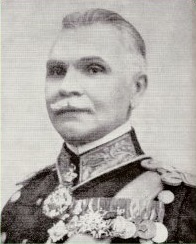Gheorghe Argeșanu
This article needs additional citations for verification. (June 2017) |
This article may be expanded with text translated from the corresponding article in Romanian. (June 2017) Click [show] for important translation instructions.
|
Gheorghe Argeșanu | |
|---|---|
 Gheorghe Argeșanu in the 1930s | |
| Minister of National Defence | |
| In office 30 March 1938 – 13 October 1938 | |
| Prime Minister of Romania | |
| In office 21 September 1939 – 28 September 1939 | |
| Preceded by | Armand Călinescu |
| Succeeded by | Constantin Argetoianu |
| Personal details | |
| Born | 28 February 1883 Caracal, Kingdom of Romania |
| Died | 26 November 1940 (aged 57) Jilava, Kingdom of Romania |
| Nationality | Romanian |
| Alma mater | University of Bucharest |
| Occupation | Soldier, politician |
| Military service | |
| Allegiance | Kingdom of Romania |
| Branch/service | Cavalry, Romanian Land Forces |
| Years of service | 1903 – 1940[1] |
| Rank | General de divizie |
| Unit | 3rd Regiment Roșiori, 2nd Regiment Călărași, 2nd Infantry Division, 4th Infantry Division, 2nd Cavalry Division[1] |
| Commands | 2nd Regiment Călărași, Guards Division[1] |
| Battles/wars | Second Balkan War, Romanian campaign (World War I), Hungarian-Romanian War |
Gheorghe Argeșanu (28 February 1883 – 26/27 November 1940) was a Romanian cavalry general[2] and politician who served as a Prime Minister of Romania for about a week in September 1939.
Biography[]
Born in Caracal, he was promoted to a leadership position in the Romanian Army during World War I, and served as the first Romanian military attaché to Japan (1921–1922)[1] and as Minister of Defense in the second Miron Cristea cabinet (March–October 1938).
Argeșanu was appointed as premier by King Carol II after the assassination of his predecessor Armand Călinescu by the nationalist Iron Guard, and promoted to the rank of Lieutenant General. His first noted measures included the public display of the bodies of Călinescu's assassins (who had been killed by orders from Horia Sima) and the arbitrary arrest and execution without trial of at least three Iron Guard members in each county. He was replaced as premier by Constantin Argetoianu.
Immediately after the establishment of the Iron Guard's National Legionary State, Argeșanu himself was imprisoned without trial in the Jilava prison, and ultimately killed there during the Jilava Massacre by members of the Iron Guard on the same night together with 63 other political prisoners, in retaliation for the violence he had endorsed.
Argeșanu was married to the pianist Manya Botez.
Gallery[]

Gheorghe Argeșanu in the 1910s
References[]
- ^ a b c d "Personalităţi Romanaţene - Gheorghe Argeşanu" (PDF). Memoria Oltului. Vol. 1, no. 4. June 2012. pp. 10–16. Retrieved 16 September 2017.
- ^ "Generals of World War II - Gheorghe Argeșanu". www.generals.dk. Retrieved 22 June 2017.
- "Gheorghe Argeșeanu". enciclopediaromaniei.ro (in Romanian).
- 1883 births
- 1940 deaths
- People from Caracal, Romania
- Prime Ministers of Romania
- Romanian Ministers of Defence
- National Renaissance Front politicians
- Romanian Land Forces generals
- Romanian military attachés
- Romanian military personnel of World War I
- Romanian people of World War II
- World War II political leaders
- Romanian people who died in prison custody
- Prisoners who died in Romanian detention
- People assassinated by the Romanian Iron Guard
- Prisoners murdered in custody
- People murdered in Romania
- Burials at Ghencea Cemetery
- Romanian politician stubs

